Different Cooling Histories of Ultrahigh-Temperature Granulites Revealed by Ti-in-Quartz: An Electron Microprobe Approach
Abstract
:1. Introduction
2. Geological Setting and Sample Descriptions
2.1. Granulites from the Khondalite Belt, North China Craton
2.2. Granulites from the Mogok Metamorphic Belt, Myanmar
3. Analytical Methods
4. Results
5. Temperature Estimation Based on TitaniQ Thermobarometer
6. Discussion
6.1. Validation of TitaniQ Thermometer for Recording UHT Metamorphic Conditions
6.2. Slow Cooling of UHT Granulites in KB
6.3. Rapid Cooling of UHT Granulites in MMB
7. Conclusions
Supplementary Materials
Author Contributions
Funding
Data Availability Statement
Acknowledgments
Conflicts of Interest
References
- Harley, S.L. Refining the P–T records of UHT crustal metamorphism. J. Metamorph. Geol. 2008, 26, 125–154. [Google Scholar] [CrossRef]
- Jiao, S.; Guo, J. Paleoproterozoic UHT metamorphism with isobaric cooling (IBC) followed by decompression–heating in the Khondalite Belt (North China Craton): New evidence from two sapphirine formation processes. J. Metamorph. Geol. 2020, 38, 357–378. [Google Scholar] [CrossRef]
- Kelsey, D.E.; Hand, M. On ultrahigh temperature crustal metamorphism: Phase equilibria, trace element thermometry, bulk composition, heat sources, timescales and tectonic settings. Geosci. Front. 2015, 6, 311–356. [Google Scholar] [CrossRef] [Green Version]
- Harley, S.L. A matter of time: The importance of the duration of UHT metamorphism. J. Mineral. Petrol. Sci. 2016, 111, 50–72. [Google Scholar] [CrossRef] [Green Version]
- Pattison, D.R.M.; Chacko, T.; Farquhar, J.; McFarlane, C.R.M. Temperatures of Granulite-facies Metamorphism: Constraints from Experimental Phase Equilibria and Thermobarometry Corrected for Retrograde Exchange. J. Petrol. 2003, 44, 867–900. [Google Scholar] [CrossRef] [Green Version]
- Wu, J.; Zhang, H.; Zhai, M.; Zhang, H.; Wang, H.; Li, R.; Hu, B.; Zhang, H. Shared metamorphic histories of various Palaeoproterozoic granulites from Datong–Huai’an area, North China Craton (NCC): Constraints from zircon U–Pb ages and petrology. Int. Geol. Rev. 2019, 61, 694–719. [Google Scholar] [CrossRef]
- Zack, T.V.; Von Eynatten, H.; Kronz, A. Rutile geochemistry and its potential use in quantitative provenance studies. Sediment. Geol. 2004, 171, 37–58. [Google Scholar] [CrossRef]
- Watson, E.; Wark, D.; Thomas, J. Crystallization thermometers for zircon and rutile. Contrib. Mineral. Petrol. 2006, 151, 413–433. [Google Scholar] [CrossRef]
- Ferry, J.; Watson, E. New thermodynamic models and revised calibrations for the Ti-in-zircon and Zr-in-rutile thermometers. Contrib. Mineral. Petrol. 2007, 154, 429–437. [Google Scholar] [CrossRef]
- Tomkins, H.; Powell, R.; Ellis, D. The pressure dependence of the zirconium-in-rutile thermometer. J. Metamorph. Geol. 2007, 25, 703–713. [Google Scholar] [CrossRef]
- Watson, E.B.; Harrison, T. Zircon thermometer reveals minimum melting conditions on earliest Earth. Science 2005, 308, 841–844. [Google Scholar] [CrossRef] [PubMed] [Green Version]
- Wark, D.A.; Watson, E.B. TitaniQ: A titanium-in-quartz geothermometer. Contrib. Mineral. Petrol. 2006, 152, 743–754. [Google Scholar] [CrossRef]
- Thomas, J.B.; Bruce Watson, E.; Spear, F.S.; Shemella, P.T.; Nayak, S.K.; Lanzirotti, A. TitaniQ under pressure: The effect of pressure and temperature on the solubility of Ti in quartz. Contrib. Mineral. Petrol. 2010, 160, 743–759. [Google Scholar] [CrossRef]
- Huang, R.; Audétat, A. The titanium-in-quartz (TitaniQ) thermobarometer: A critical examination and re-calibration. Geochim. Cosmochim. Acta 2012, 84, 75–89. [Google Scholar] [CrossRef]
- Zhang, C.; Li, X.; Almeev, R.R.; Horn, I.; Behrens, H.; Holtz, F. Ti-in-quartz thermobarometry and TiO2 solubility in rhyolitic melts: New experiments and parametrization. Earth Planet. Sci. Lett. 2020, 538, 116213. [Google Scholar] [CrossRef]
- Altenberger, U.; Mejia Jimenez, D.; Günter, C.; Sierra Rodriguez, G.; Scheffler, F.; Oberhänsli, R. The Garzón Massif, Colombia-a new ultrahigh-temperature metamorphic complex in the Early Neoproterozoic of northern South America. Mineral. Petrol. 2012, 105, 171–185. [Google Scholar] [CrossRef]
- Ewing, T.A.; Hermann, J.; Rubatto, D. The robustness of the Zr-in-rutile and Ti-in-zircon thermometers during high-temperature metamorphism (Ivrea-Verbano Zone, northern Italy). Contrib. Mineral. Petrol. 2012, 165, 757–779. [Google Scholar] [CrossRef]
- Tual, L.; Möller, C.; Whitehouse, M. Tracking the prograde P–T path of Precambrian eclogite using Ti-in-quartz and Zr-in-rutile geothermobarometry. Contrib. Mineral. Petrol. 2018, 173, 56. [Google Scholar] [CrossRef] [Green Version]
- Cherniak, D.; Watson, E.; Wark, D. Ti diffusion in quartz. Chem. Geol. 2007, 236, 65–74. [Google Scholar] [CrossRef]
- Sato, K.; Santosh, M. Titanium in quartz as a record of ultrahigh-temperature metamorphism: The granulites of Karur, southern India. Mineral. Mag. 2007, 71, 143–154. [Google Scholar] [CrossRef]
- Storm, L.; Spear, F. Application of the titanium-in-quartz thermometer to pelitic migmatites from the Adirondack Highlands, New York. J. Metamorph. Geol. 2009, 27, 479–494. [Google Scholar] [CrossRef]
- Müller, A.; Wiedenbeck, M.; van den Kerkhof, A.M.; Kronz, A.; Simon, K. Trace elements in quartz—A combined electron microprobe, secondary ion mass spectrometry, laser-ablation ICP-MS, and cathodoluminescence study. Eur. J. Mineral. 2003, 15, 747–763. [Google Scholar] [CrossRef]
- Jourdan, A.-L.V.; Mullis, J.; Ramseyer, K.; Spiers, C.J. Evidence of growth and sector zoning in hydrothermal quartz from Alpine veins. Eur. J. Mineral. 2009, 21, 219–231. [Google Scholar] [CrossRef]
- Lehmann, K.; Berger, A.; Gotte, T.; Ramseyer, K.; Wiedenbeck, M. Growth related zonations in authigenic and hydrothermal quartz characterized by SIMS-, EPMA-, SEM-CL-and SEM-CC-imaging. Mineral. Mag. 2009, 73, 633–643. [Google Scholar] [CrossRef]
- Behr, W.M.; Thomas, J.B.; Hervig, R.L. Calibrating Ti concentrations in quartz for SIMS determinations using NIST silicate glasses and application to the TitaniQ geothermobarometer. Am. Mineral. 2011, 96, 1100–1106. [Google Scholar] [CrossRef]
- Donovan, J.J.; Lowers, H.A.; Rusk, B.G. Improved electron probe microanalysis of trace elements in quartz. Am. Mineral. 2011, 96, 274–282. [Google Scholar] [CrossRef]
- Tanner, D.; Henley, R.W.; Mavrogenes, J.A.; Holden, P. Combining in situ isotopic, trace element and textural analyses of quartz from four magmatic-hydrothermal ore deposits. Contrib. Mineral. Petrol. 2013, 166, 1119–1142. [Google Scholar] [CrossRef]
- Audétat, A.; Garbe-Schönberg, D.; Kronz, A.; Pettke, T.; Rusk, B.; Donovan, J.J.; Lowers, H.A. Characterisation of a Natural Quartz Crystal as a Reference Material for Microanalytical Determination of Ti, Al, Li, Fe, Mn, Ga and Ge. Geostand. Geoanal. Res. 2015, 39, 171–184. [Google Scholar] [CrossRef] [Green Version]
- Cruz-Uribe, A.M.; Mertz-Kraus, R.; Zack, T.; Feineman, M.D.; Woods, G.; Jacob, D.E. A New LA-ICP-MS Method for Ti in Quartz: Implications and Application to High Pressure Rutile-Quartz Veins from the Czech Erzgebirge. Geostand. Geoanal. Res. 2016, 41, 29–40. [Google Scholar] [CrossRef]
- Guillong, M.; Günther, D. Effect of particle size distribution on ICP-induced elemental fractionation in laser ablation-inductively coupled plasma-mass spectrometry. J. Anal. At. Spectrom. 2002, 17, 831–837. [Google Scholar] [CrossRef]
- Sylvester, P.J. LA-(MC)-ICP-MS trends in 2006 and 2007 with particular emphasis on measurement uncertainties. Geostand. Geoanal. Res. 2008, 32, 469–488. [Google Scholar] [CrossRef]
- Wu, S.T.; Xu, C.X.; Simon, K.; Xiao, Y.L.; Wang, Y.P. Study on Ablation Behaviors and Ablation Rates of a 193nm ArF Excimer Laser System for Selected Substrates in LA-ICP-MS analysis. Rock Miner. Anal. 2017, 36, 451–459. [Google Scholar]
- Kendrick, J.; Indares, A. The Ti record of quartz in anatectic aluminous granulites. J. Petrol. 2018, 59, 1493–1516. [Google Scholar] [CrossRef]
- Zhao, G.; Sun, M.; Wilde, S.A.; Sanzhong, L. Late Archean to Paleoproterozoic evolution of the North China Craton: Key issues revisited. Precambrian Res. 2005, 136, 177–202. [Google Scholar] [CrossRef]
- Santosh, M.; Tsunogae, T.; Li, J.; Liu, S. Discovery of sapphirine-bearing Mg–Al granulites in the North China Craton: Implications for Paleoproterozoic ultrahigh temperature metamorphism. Gondwana Res. 2007, 11, 263–285. [Google Scholar] [CrossRef]
- Santosh, M.; Wan, Y.; Liu, D.; Chunyan, D.; Li, J. Anatomy of zircons from an ultrahot orogen: The amalgamation of the North China Craton within the supercontinent Columbia. J. Geol. 2009, 117, 429–443. [Google Scholar] [CrossRef]
- Yin, C.; Zhao, G.; Sun, M.; Xia, X.; Wei, C.; Zhou, X.; Leung, W. LA-ICP-MS U–Pb zircon ages of the Qianlishan Complex: Constrains on the evolution of the Khondalite Belt in the Western Block of the North China Craton. Precambrian Res. 2009, 174, 78–94. [Google Scholar] [CrossRef]
- Jiao, S.; Guo, J.; Mao, Q.; Zhao, R. Application of Zr-in-rutile thermometry: A case study from ultrahigh-temperature granulites of the Khondalite belt, North China Craton. Contrib. Mineral. Petrol. 2011, 162, 379–393. [Google Scholar] [CrossRef]
- Jiao, S.; Guo, J. Application of the two-feldspar geothermometer to ultrahigh-temperature (UHT) rocks in the Khondalite belt, North China craton and its implications. Am. Mineral. 2011, 96, 250–260. [Google Scholar] [CrossRef]
- Yang, Q.-Y.; Santosh, M.; Tsunogae, T. Ultrahigh-temperature metamorphism under isobaric heating: New evidence from the North China Craton. J. Asian Earth Sci. 2014, 95, 2–16. [Google Scholar] [CrossRef]
- Li, X.; Wei, C. Ultrahigh-temperature metamorphism in the Tuguiwula area, Khondalite Belt, North China Craton. J. Metamorph. Geol. 2018, 36, 489–509. [Google Scholar] [CrossRef]
- Li, X.; White, R.W.; Wei, C. Can we extract ultrahigh-temperature conditions from Fe-rich metapelites? An example from the Khondalite Belt, North China Craton. Lithos 2019, 328, 228–243. [Google Scholar] [CrossRef] [Green Version]
- Wang, B.; Wei, C.-J.; Tian, W. Evolution of spinel-bearing ultrahigh-temperature granulite in the Jining complex, North China Craton: Constrained by phase equilibria and Monte Carlo methods. Mineral. Petrol. 2021, 115, 283–297. [Google Scholar] [CrossRef]
- Guo, J.H.; Wang, S.S. 40Ar-39Ar age spectra of garnet porphyroblast: Implications for metamorphic age of high-pressure granulite in the North China Craton. Acta Petrol. Sin. 2001, 17, 436–442. [Google Scholar]
- Barley, M.E.; Pickard, A.L.; Zaw, K.; Rak, P.; Doyle, M.G. Jurassic to Miocene magmatism and metamorphism in the Mogok metamorphic belt and the India-Eurasia collision in Myanmar. Tectonics 2003, 22, 1019–1030. [Google Scholar] [CrossRef]
- Mitchell, A.H.G.; Htay, M.T.; Htun, K.M.; Win, M.N.; Oo, T.; Hlaing, T. Rock relationships in the Mogok metamorphic belt, Tatkon to Mandalay, central Myanmar. J. Asian Earth Sci. 2007, 29, 891–910. [Google Scholar] [CrossRef]
- Searle, M.P.; Noble, S.R.; Cottle, J.M.; Waters, D.J.; Mitchell, A.H.G.; Hlaing, T.; Horstwood, M.S.A. Tectonic evolution of the Mogok metamorphic belt, Burma (Myanmar) constrained by U-Th-Pb dating of metamorphic and magmatic rocks. Tectonics 2007, 26, TC3014. [Google Scholar] [CrossRef]
- Mitchell, A.; Chung, S.-L.; Oo, T.; Lin, T.-H.; Hung, C.-H. Zircon U–Pb ages in Myanmar: Magmatic–metamorphic events and the closure of a neo-Tethys ocean? J. Asian Earth Sci. 2012, 56, 1–23. [Google Scholar] [CrossRef]
- Zhang, D.; Guo, S.; Chen, Y.; Li, Q.; Ling, X.; Liu, C.; Sein, K. ~25 Ma Ruby Mineralization in the Mogok Stone Tract, Myanmar: New Evidence from SIMS U–Pb Dating of Coexisting Titanite. Minerals 2021, 11, 536. [Google Scholar] [CrossRef]
- Yonemura, K.; Osanai, Y.; Nakano, N.; Adachi, T.; Charusiri, P.; Zaw, T.N. EPMA U-Th-Pb monazite dating of metamorphic rocks from the Mogok Metamorphic Belt, central Myanmar. J. Mineral. Petrol. Sci. 2013, 108, 184–188. [Google Scholar] [CrossRef] [Green Version]
- Thu, Y.K.; Win, M.M.; Enami, M.; Tsuboi, M. Ti–rich biotite in spinel and quartz–bearing paragneiss and related rocks from the Mogok metamorphic belt, central Myanmar. J. Mineral. Petrol. Sci. 2016, 111, 151020. [Google Scholar]
- Win, M.M.; Enami, M.; Kato, T. Metamorphic conditions and CHIME monazite ages of Late Eocene to Late Oligocene high-temperature Mogok metamorphic rocks in central Myanmar. J. Asian Earth Sci. 2016, 117, 304–316. [Google Scholar] [CrossRef]
- Thu, Y.K.; Enami, M.; Kato, T.; Tsuboi, M. Granulite facies paragneisses from the middle segment of the Mogok metamorphic belt, central Myanmar. J. Mineral. Petrol. Sci. 2017, 112, 1–19. [Google Scholar]
- Chen, S.; Chen, Y.; Li, Y.; Su, B.; Zhang, Q.; Aung, M.M.; Sein, K. Cenozoic ultrahigh-temperature metamorphism in pelitic granulites from the Mogok metamorphic belt, Myanmar. Sci. China: Earth Sci. 2021, 64, 1873–1892. [Google Scholar] [CrossRef]
- Bertrand, G.; Rangin, C.; Maluski, H.; Bellon, H. Diachronous cooling along the Mogok Metamorphic Belt (Shan scarp, Myanmar): The trace of the northward migration of the Indian syntaxis. J. Asian Earth Sci. 2001, 19, 649–659. [Google Scholar] [CrossRef]
- Bertrand, G.; Rangin, C. Tectonics of the western margin of the Shan plateau (central Myanmar): Implication for the India–Indochina oblique convergence since the Oligocene. J. Asian Earth Sci. 2003, 21, 1139–1157. [Google Scholar] [CrossRef]
- Garnier, V.; Maluski, H.; Giuliani, G.; Ohnenstetter, D.; Schwarz, D. Ar-Ar and U-Pb ages of marble-hosted ruby deposits from central and southeast Asia. Can. J. Earth Sci. 2006, 43, 509–532. [Google Scholar] [CrossRef]
- Themelis, T. Gems and Mines of Mogok; A&T Pub.: Los Angeles, CA, USA, 2008. [Google Scholar]
- Whitney, D.L.; Evans, B.W. Abbreviations for names of rock-forming minerals. Am. Mineral. 2010, 95, 185–187. [Google Scholar] [CrossRef]
- Batanova, V.G.; Sobolev, A.V.; Kuzmin, D.V. Trace element analysis of olivine: High precision analytical method for JEOL JXA-8230 electron probe microanalyser. Chem. Geol. 2015, 419, 149–157. [Google Scholar] [CrossRef]
- Ancey, M.; Bastenaire, F.; Tixier, R. Applications of statistical methods in microanalysis. In Proc. Summer School St. Martin-d’Herres; Maurice, F., Ed.; Les Editions de Physique: Orsay, France, 1978; pp. 319–343. [Google Scholar]
- Thomas, J.B.; Watson, E.B.; Spear, F.S.; Wark, D. TitaniQ recrystallized: Experimental confirmation of the original Ti-in-quartz calibrations. Contrib. Mineral. Petrol. 2015, 169, 27. [Google Scholar] [CrossRef]
- Osborne, Z.R.; Thomas, J.B.; Nachlas, W.O.; Baldwin, S.L.; Holycross, M.E.; Spear, F.S.; Watson, E.B. An experimentally calibrated thermobarometric solubility model for titanium in coesite (TitaniC). Contrib. Mineral. Petrol. 2019, 174, 34. [Google Scholar] [CrossRef]
- Horton, F.; Hacker, B.; Kylander-Clark, A.; Holder, R.; Jöns, N. Focused radiogenic heating of middle crust caused ultrahigh temperatures in southern Madagascar. Tectonics 2016, 35, 293–314. [Google Scholar] [CrossRef] [Green Version]
- Sanborn-Barrie, M.; Camacho, A.; Berman, R. High-pressure, ultrahigh-temperature 1.9 Ga metamorphism of the Kramanituar Complex, Snowbird Tectonic Zone, Rae Craton, Canada. Contrib. Mineral. Petrol. 2019, 174, 14. [Google Scholar] [CrossRef]
- Ramírez-Salazar, A.; Almazán-López, M.D.M.; Colás, V.; Ortega-Gutiérrez, F. Multi-thermobarometry and microstructures reveal ultra-high temperature metamorphism in the Grenvillian Oaxacan Complex, Southern Mexico. Int. Geol. Rev. 2022, 65, 1331–1353. [Google Scholar] [CrossRef]
- Zheng, Y.; Qi, Y.; Zhang, D.; Jiao, S.; Huang, G.; Guo, J. New Insight From the First Application of Ti-in-Quartz (TitaniQ) Thermometry Mapping in the Eastern Khondalite Belt, North China Craton. Front. Earth Sci. 2022, 10, 860057. [Google Scholar] [CrossRef]
- Jiao, S.; Guo, J.; Harley, S.L.; Peng, P. Geochronology and trace element geochemistry of zircon, monazite and garnet from the garnetite and/or associated other high-grade rocks: Implications for Palaeoproterozoic tectonothermal evolution of the Khondalite Belt, North China Craton. Precambrian Res. 2013, 237, 78–100. [Google Scholar] [CrossRef]
- Jiao, S.; Guo, J.; Harley, S.L.; Windley, B.F. New constraints from garnetite on the P–T path of the Khondalite Belt: Implications for the tectonic evolution of the North China Craton. J. Petrol 2013, 54, 1725–1758. [Google Scholar] [CrossRef] [Green Version]
- Pape, J.; Mezger, K.; Robyr, M. A systematic evaluation of the Zr-in-rutile thermometer in ultra-high temperature (UHT) rocks. Contrib. Mineral. Petrol. 2016, 171, 44. [Google Scholar] [CrossRef]
- Li, X.; Wei, C. Phase equilibria modelling and zircon age dating of pelitic granulites in Zhaojiayao, from the Jining Group of the Khondalite Belt, North China Craton. J. Metamorph. Geol. 2016, 34, 595–615. [Google Scholar] [CrossRef]
- Wan, Y.; Song, B.; Liu, D.; Wilde, S.A.; Wu, J.; Shi, Y.; Yin, X.; Zhou, H. SHRIMP U–Pb zircon geochronology of Palaeoproterozoic metasedimentary rocks in the North China Craton: Evidence for a major Late Palaeoproterozoic tectonothermal event. Precambrian Res. 2006, 149, 249–271. [Google Scholar] [CrossRef]
- Cai, J.; Liu, F.L.; Liu, P.H.; Shi, J.R. Metamorphic P-T conditions and U-Pb dating of the sillimanite-cordierite-garnet paragneisses in Sanchakou, Jining area, Inner Mongolia. Acta Petrol. Sin. 2014, 30, 472–490. [Google Scholar]
- Jiao, S.; Guo, J.; Evans, N.J.; Mcdonald, B.J.; Liu, P.; Ouyang, D.; Fitzsimons, I.C. The timing and duration of high-temperature to ultrahigh-temperature metamorphism constrained by zircon U–Pb–Hf and trace element signatures in the Khondalite Belt, North China Craton. Contrib. Mineral. Petrol. 2020, 175, 66. [Google Scholar] [CrossRef]
- Chen, Y.; Chen, S.; Su, B.; Li, Y.B.; Gu, S. Trace element systematics of granulite facie rutile. J. Earth Sci. 2018, 43, 127–149. [Google Scholar]

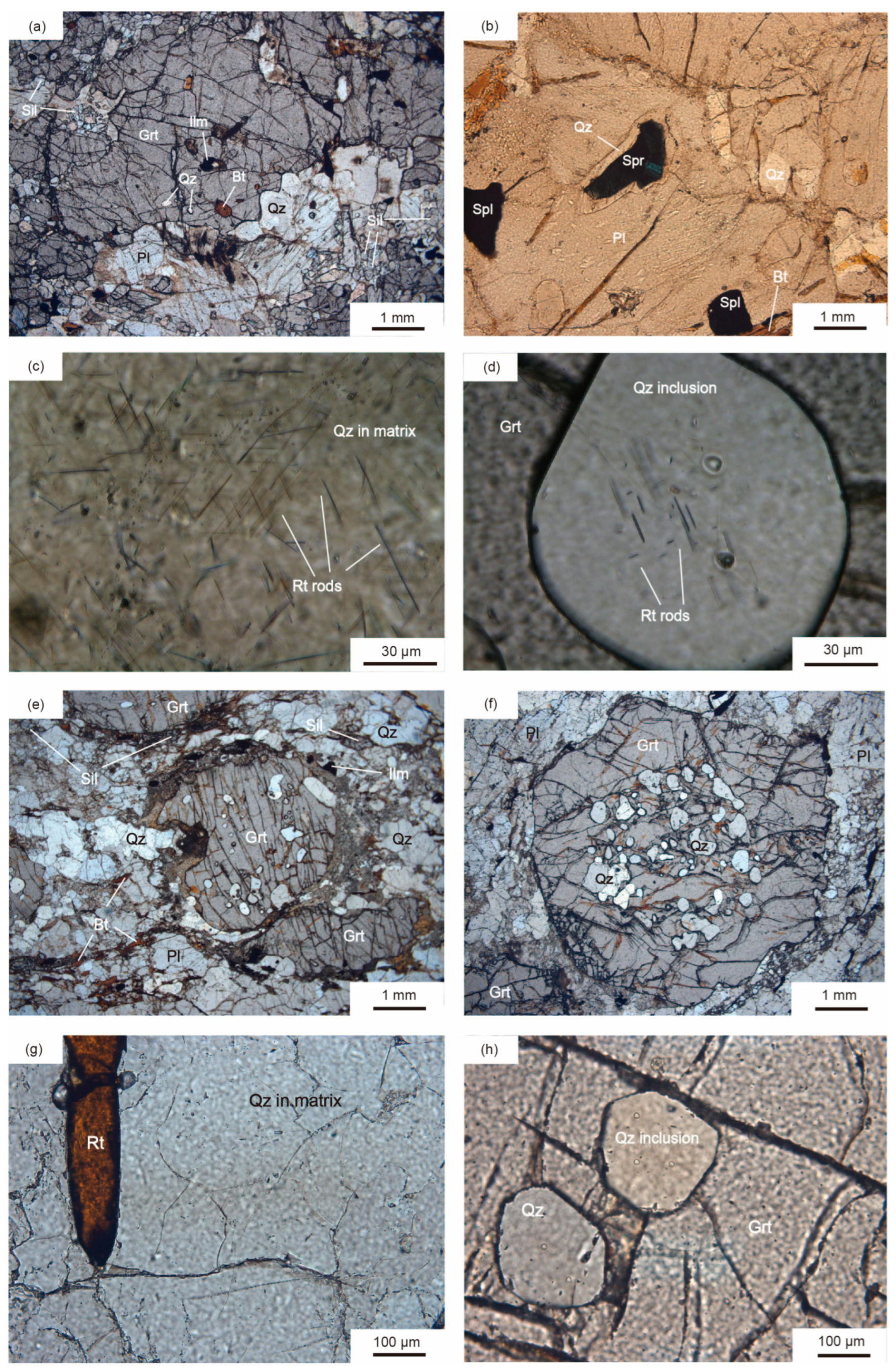
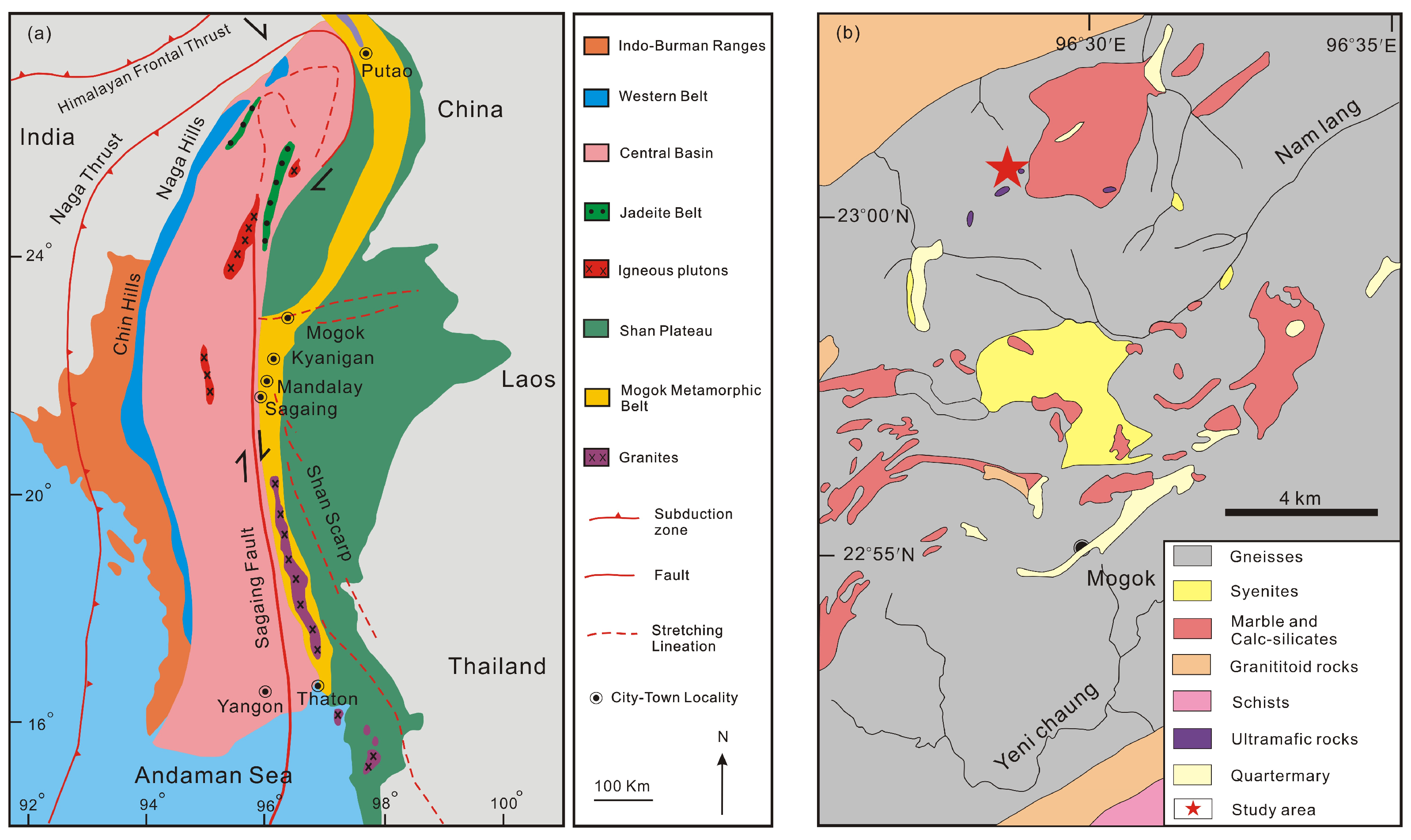
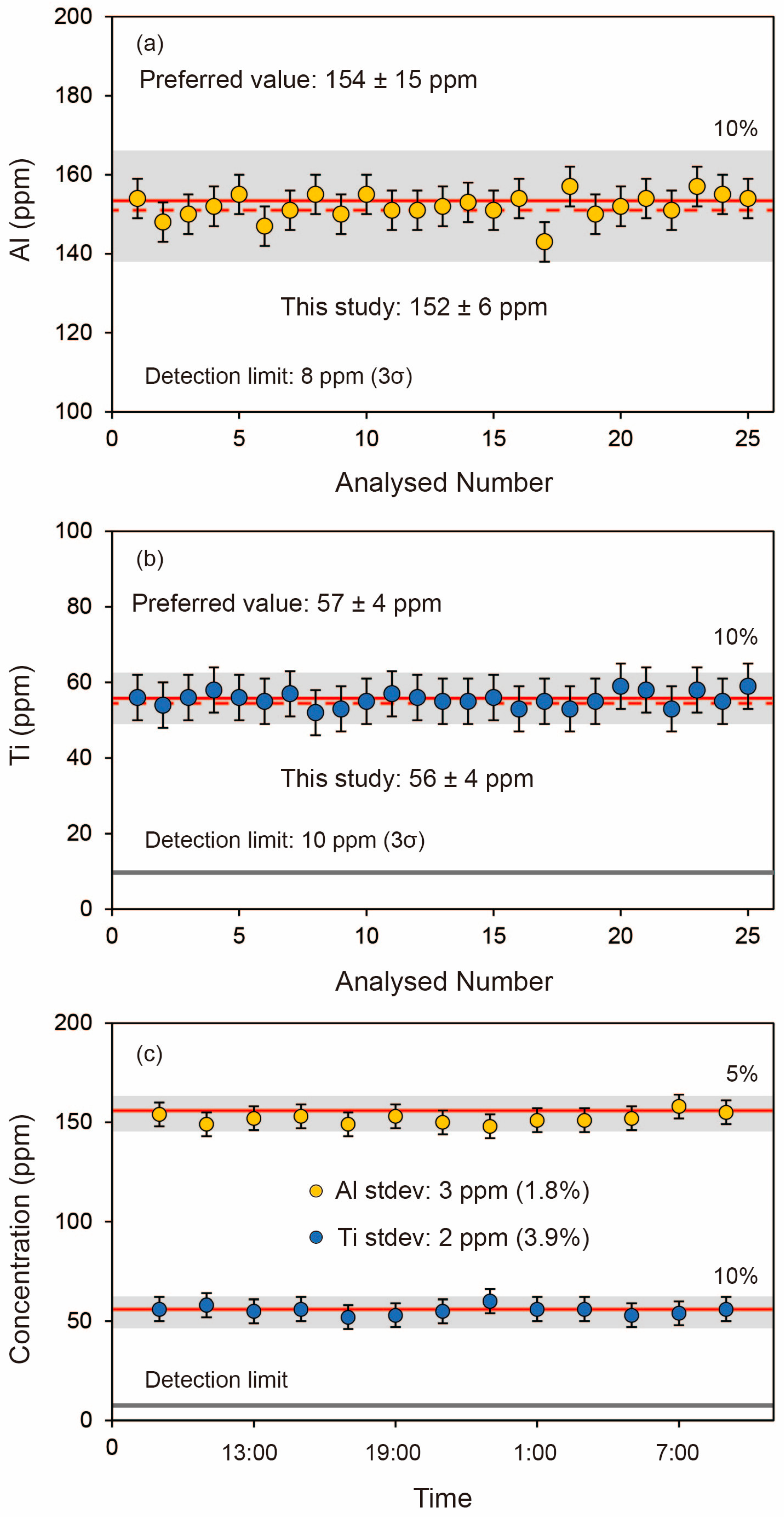
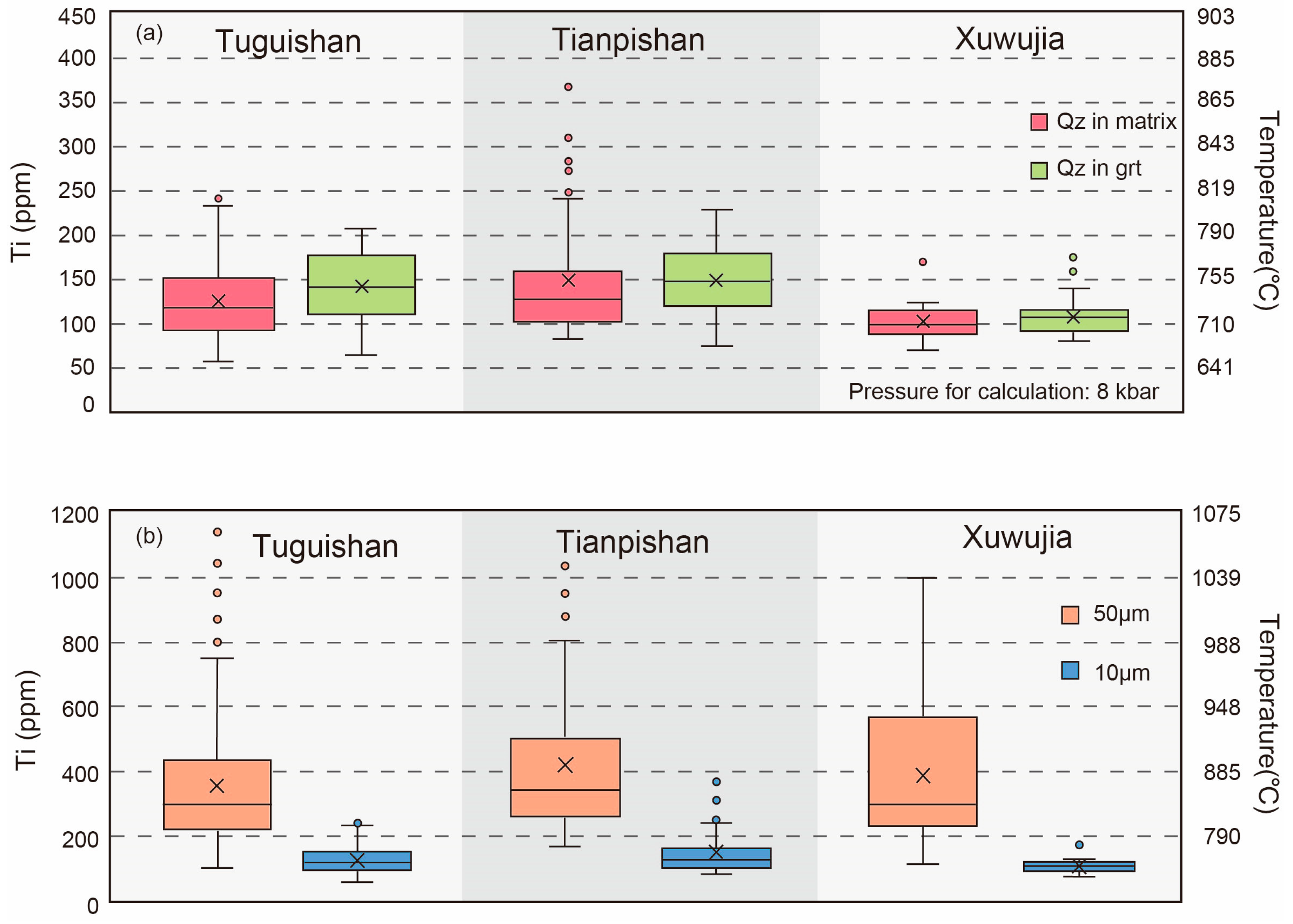
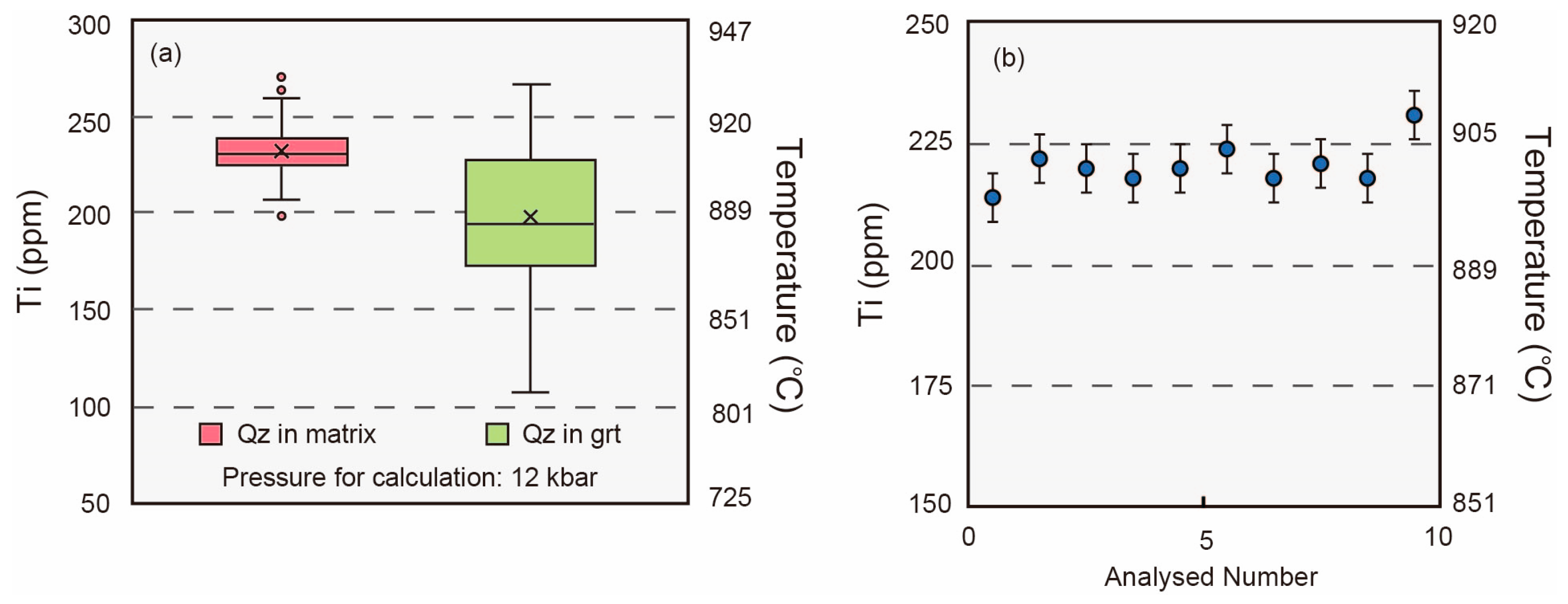
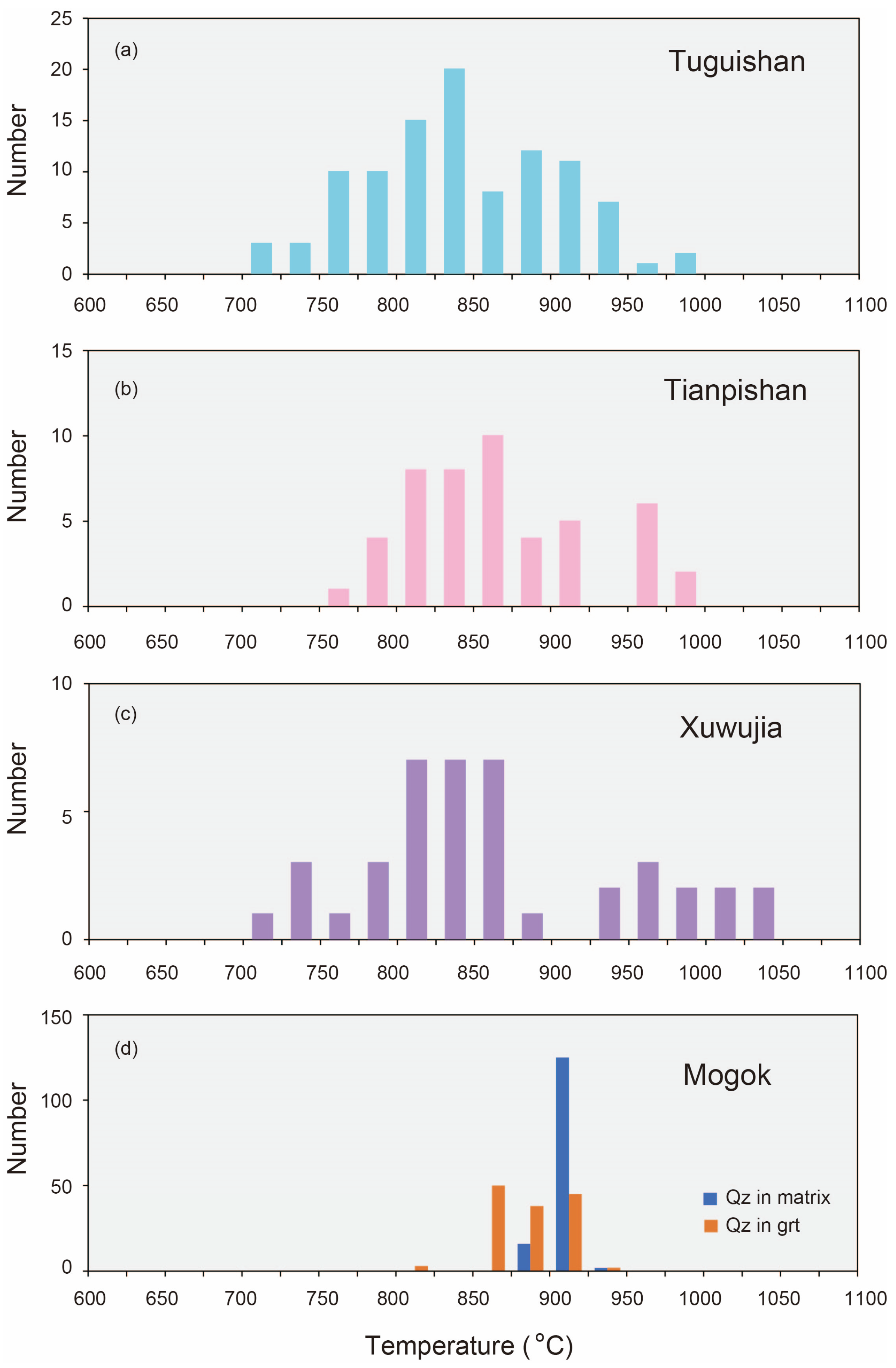
| Locality | Lithology | Sample | Peak Mineral Assemblage 1 |
|---|---|---|---|
| Khondalite Belt, North China Craton | |||
| Tuguishan | Grt–Sil granulite | 08TG06A, 08TG06B | Grt + Sil + Spl + Kfs + Pl + Bt + Qz + Rt + Zrn + Ilm |
| Tianpishan | Garnet–sillimanite–sapphirine granulite | 08TPS09, 08TPS11 | Grt + Sil + Spr + Spl + Kfs + Pl + Qz + Opx + Rt + Zrn + Ilm |
| Xuwujia | Grt–Sil–Bt–Pl granulite | 08XWJ01 | Grt + Sil + Kfs + Pl + Qz + Rt ± Bt + Zrn + Ilm |
| Mogok Metamorphic Belt, Myanmar | |||
| Htin-ShuTaung | Grt granulite | 19MDL115-2, 19MDL115-3, 19MDL119-2, 19MDL126-1, 19MDL126-2 | Grt + Sil + Pl + Kfs ± Bt + Rt + Qz + Zrn + Ilm |
Disclaimer/Publisher’s Note: The statements, opinions and data contained in all publications are solely those of the individual author(s) and contributor(s) and not of MDPI and/or the editor(s). MDPI and/or the editor(s) disclaim responsibility for any injury to people or property resulting from any ideas, methods, instructions or products referred to in the content. |
© 2023 by the authors. Licensee MDPI, Basel, Switzerland. This article is an open access article distributed under the terms and conditions of the Creative Commons Attribution (CC BY) license (https://creativecommons.org/licenses/by/4.0/).
Share and Cite
Zhang, D.; Chen, Y.; Mao, Q.; Jiao, S.; Su, B.; Chen, S.; Sein, K. Different Cooling Histories of Ultrahigh-Temperature Granulites Revealed by Ti-in-Quartz: An Electron Microprobe Approach. Crystals 2023, 13, 1116. https://doi.org/10.3390/cryst13071116
Zhang D, Chen Y, Mao Q, Jiao S, Su B, Chen S, Sein K. Different Cooling Histories of Ultrahigh-Temperature Granulites Revealed by Ti-in-Quartz: An Electron Microprobe Approach. Crystals. 2023; 13(7):1116. https://doi.org/10.3390/cryst13071116
Chicago/Turabian StyleZhang, Di, Yi Chen, Qian Mao, Shujuan Jiao, Bin Su, Si Chen, and Kyaing Sein. 2023. "Different Cooling Histories of Ultrahigh-Temperature Granulites Revealed by Ti-in-Quartz: An Electron Microprobe Approach" Crystals 13, no. 7: 1116. https://doi.org/10.3390/cryst13071116
APA StyleZhang, D., Chen, Y., Mao, Q., Jiao, S., Su, B., Chen, S., & Sein, K. (2023). Different Cooling Histories of Ultrahigh-Temperature Granulites Revealed by Ti-in-Quartz: An Electron Microprobe Approach. Crystals, 13(7), 1116. https://doi.org/10.3390/cryst13071116







